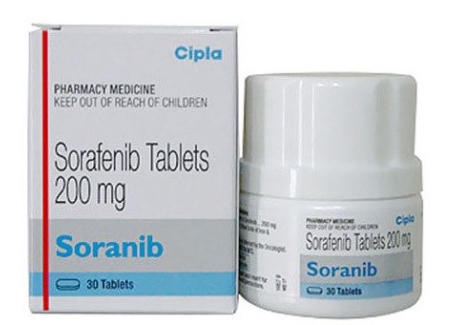Nikhil Prasad Fact checked by:Thailand Medical News Team Dec 22, 2024 1 year, 6 days, 3 hours, 10 minutes ago
Medical News: Sorafenib, a groundbreaking multi-targeted anti-cancer drug, has been widely used for treating hepatocellular carcinoma, advanced renal cell carcinoma, and differentiated thyroid carcinoma. These cancers represent significant global health burdens. Hepatocellular carcinoma alone is the sixth most common cancer worldwide and the third leading cause of cancer-related deaths. Sorafenib works by blocking tumor cell growth and disrupting tumor vascularization, providing a dual mechanism of action that has made it a cornerstone in oncological therapies. However, its side effects and safety profile remain complex and require continuous monitoring.
 Insights from a New Pharmacovigilance Study on Sorafenib (Part 1)
Purpose of the Study
Insights from a New Pharmacovigilance Study on Sorafenib (Part 1)
Purpose of the Study
Researchers from the School of Medicine at Xiamen University, China, conducted an extensive pharmacovigilance study using the FDA Adverse Event Reporting System (FAERS) database. This
Medical News report (A series of 5 parts covering 5 different Pharmacovigilance Studies) focuses on their work, which aimed to monitor and identify adverse events (AEs) associated with Sorafenib. The study covered a 20-year period, from the first quarter of 2004 to the first quarter of 2024, analyzing over 18,600 patients who reported more than 82,800 adverse events.
The findings provide crucial insights for healthcare providers, enabling them to manage risks better and improve patient safety. By focusing on real-world data, the researchers aimed to bridge the gap between clinical trials and everyday clinical practice.
Methodology and Analysis
The researchers adopted a disproportionality analysis approach, which involves sophisticated data-mining algorithms to quantify safety signals linked to drug use. Four statistical methods were used: Reporting Odds Ratio (ROR), Proportional Reporting Ratio (PRR), Bayesian Confidence Propagation Neural Network (BCPNN), and Multi-Item Gamma Poisson Shrinkage (MGPS).
Each of these methods offered unique insights into the intensity and frequency of adverse events. Data cleaning procedures ensured the removal of duplicate and erroneous records, maintaining the integrity of the analysis. The final dataset comprised a comprehensive profile of Sorafenib’s safety across diverse patient groups.
Key Findings
One of the study's pivotal findings was the identification of adverse events affecting 26 organ systems. The most common adverse events included gastrointestinal issues such as diarrhea, skin disorders like palmar-plantar erythrodysaesthesia syndrome, and general symptoms such as fatigue. These findings were largely consistent with existing drug labels and clinical trial data.
Interestingly, the study also uncovered previously undocumented adverse events. These include:
-Gait inability:
A rare but debilitating condition that may arise due to neurological or musculoskeletal complications.
-Palmoplantar keratoderma
and hyperkeratosis:
These skin conditions, while rare, highlight the need for careful dermatological monitoring.
The most severe adverse events were linked to gastrointestinal and hepatic systems, with hepatocellular carcinoma and hepatic failure being particularly significant. These findings emphasize the need for vigilant monitoring, especially during the initial treatment phase.
Demographic Insights
The study revealed that males were more frequently affected (66.89%) than females (26.30%), and most patients were older than 65 years. The highest number of reports came from physicians and consumers, with serious cases accounting for 88.50% of the total. Outcomes often required hospitalization, reflecting the severity of adverse events.
Clinical Implications
The results underline the importance of early detection and management of adverse events. For instance:
-Skin disorders: Palmar-plantar erythrodysaesthesia syndrome, a condition causing redness, swelling, and pain in the hands and feet, requires timely intervention to prevent deterioration.
-Hepatic issues: The study highlights the risk of hepatic failure and associated complications, necessitating close monitoring of liver function in patients.
Additionally, the study provides evidence for drug resistance mechanisms, particularly in cases of hepatocellular carcinoma. Resistance to Sorafenib often develops within six months of treatment, driven by factors such as epigenetics and tumor microenvironment changes. These insights pave the way for combination therapies aimed at overcoming resistance and improving outcomes.
Limitations of the Study
While the study offers valuable insights, it also acknowledges certain limitations:
The FAERS database relies on voluntary reporting, leading to potential underreporting or reporting biases.
Rare adverse events may not achieve statistical significance due to low incidence rates.
The impact of concomitant medications and other variables, such as dosage and patient health status, remains partially unexplored.
Despite these limitations, the study’s findings provide a solid foundation for further research and clinical guidelines.
Conclusions
This comprehensive pharmacovigilance study sheds light on the safety profile of Sorafenib, identifying both known and previously undocumented adverse events. For clinicians, these findings emphasize the importance of individualized treatment plans, vigilant monitoring, and prompt management of side effects.
Furthermore, the study highlights the need for ongoing research to address drug resistance and optimize therapeutic strategies. Combination therapies and advanced drug delivery systems, such as nanoparticles, show promise in enhancing Sorafenib’s efficacy and reducing its side effects. These innovations represent the next frontier in cancer treatment, offering hope for improved patient outcomes.
The study findings were published in the peer-reviewed journal: Frontiers in Pharmacology.
https://www.frontiersin.org/journals/pharmacology/articles/10.3389/fphar.2024.1442765/full
For the latest on Sorafenib, keep on logging to Thailand
Medical News.
Read Also:
https://www.thailandmedical.news/news/breaking-medical-news-international-study-shows-that-young-individuals-who-got-ct-scans-have-an-increased-risk-of-developing-cancer
https://www.thailandmedical.news/news/new-u-s-fda-warning-for-weight-loss-drugs-ozempic-and-wegovy
https://www.thailandmedical.news/news/medical-news-study-shows-that-long-term-use-of-painkillers-in-young-adults-and-children-can-lead-to-mental-illness-and-substance-misuse
